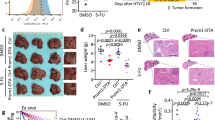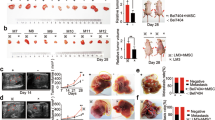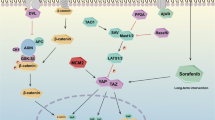Abstract
Hepatoma exhibits a series of heterogeneous subpopulations in its cell surface markers, tumorigenicity, invasion and metastatic capability. We previously demonstrated that the CD133−/EpCAM− hepatoma subpopulation was more metastatic than its counterpart; however, the controlling mechanisms are unexplored. The present study aimed to delineate the significance of aberrant hedgehog (Hh) signaling in the mediation of metastases. Fluorescence-activated cell sorting-enriched CD133−/EpCAM− (double negative, DN), Huh-7 cells underwent a transwell selection for metastatic cells (transwell-selected, TS). The TS cells displayed much greater metastatic activity as evidenced by an increased invasion rate, extremely upregulated expression of matrix metalloproteinase (MMP)-1/2/9 genes compared with DN and double-positive (DP) subpopulations. In contrast to DP cells, TS cells lost E-cadherin and were all vimentin-positive as shown by immunocytochemistry. There was a transitional increase in Gli-1/2 gene expression levels from DP, DN to TS subpopulations, which was consistent with elevated Gli-1/2 or Twist-1 protein levels in the nuclear fraction. Furthermore, truncated Gli-1 (tGli-1), which transactivates molecules involved in metastasis, was detected in the highly invasive Huh-7 cell subpopulation, but not in less metastatic hepatoma cells or normal hepatocytes. The enhanced metastatic features with increased expression of MMPs as well as the presence of twist and snail genes in TS Huh-7 cells were reversed by LDE225, a potent Smoothened antagonist. In conclusion, the highly metastatic capability of a unique TS subpopulation was highly attributed to significant epithelial–mesenchymal transition, enhanced Hh activity and aberrant occurrence of a tGli-1 variant, which appears to be responsible for the highly invasive behavior.
This is a preview of subscription content, access via your institution
Access options
Subscribe to this journal
Receive 50 print issues and online access
$259.00 per year
only $5.18 per issue
Buy this article
- Purchase on Springer Link
- Instant access to full article PDF
Prices may be subject to local taxes which are calculated during checkout






Similar content being viewed by others
Abbreviations
- DAPI:
-
4', 6-diamidino-2-phenylindole
- DP:
-
double-positive subpopulation (CD133+/EpCAM+)
- DN:
-
double-negative subpopulation (CD133−/EpCAM−)
- EMT:
-
epithelial–mesenchymal transition
- FACS:
-
fluorescence-activation cell sorting
- GAPDH:
-
glyceraldehyde phosphate dehydrogenase
- HCC:
-
hepatocellular carcinoma
- Hh:
-
hedgehog
- TS:
-
CD133−/EpCAM− transwell-selected
- MMP:
-
matrix metalloproteinase
- RT–PCR:
-
reverse transcriptase polymerase chain reaction
References
Altekruse SF, McGlynn KA, Reichman ME . Hepatocellular carcinoma incidence, mortality, and survival trends in the United States from 1975 to 2005. J Clin Oncol 2009; 27: 1485–1491.
Fattovich G, Stroffolini T, Zagni I, Donato F . Hepatocellular carcinoma in cirrhosis: incidence and risk factors. Gastroenterology 2004; 127: S35–S50.
Fouzas I, Sotiropoulos GC, Molmenti EP, Beckebaum S, Schmitz KJ, Broelsch CE et al. "Preemptive" live donor liver transplantation for fibrolamellar hepatocellular carcinoma: a case report. Transplant Proc 2008; 40: 3806–3807.
Venook AP, Papandreou C, Furuse J, de Guevara LL . The incidence and epidemiology of hepatocellular carcinoma: a global and regional perspective. Oncologist 2010; 15: 5–13.
Tang ZY, Ye SL, Liu YK, Qin LX, Sun HC, Ye QH et al. A decade's studies on metastasis of hepatocellular carcinoma. J Cancer Res Clin Oncol 2004; 130: 187–196.
Sasaki K, Matsuda M, Ohkura Y, Kawamura Y, Inoue M, Hashimoto M et al. In hepatocellular carcinomas, any proportion of poorly differentiated components is associated with poor prognosis after hepatectomy. Worid J Surg 2014; 38: 1147–1153.
Lum L, Beachy PA . The Hedgehog response network: sensors, switches, and routers. Science 2004; 304: 1755–1759.
Ruiz I, Altaba A, Mas C, Stecca B . The Gli code: an information nexus regulating cell fate, stemness and cancer. Trends Cell Biol 2007; 17: 438–447.
Katoh Y, Katoh M . Hedgehog signaling, epithelial-to-mesenchymal transition and miRNA (review). Int J Mol Med 2008; 22: 271–275.
McNeill B, Perez-Iratxeta C, Mazerolle C, Furimsky M, Mishina Y, Andrade-Navarro MA et al. Comparative genomics identification of a novel set of temporally regulated hedgehog target genes in the retina. Mol Cell Neurosci 2012; 49: 333–340.
Kinzler KW, Vogelstein B . The GLI gene encodes a nuclear protein which binds specific sequences in the human genome. Mol Cell Biol 1990; 10: 634–642.
Eichenmuller M, Gruner I, Hagl B, Haberle B, Muller-Hocker J, von Schweinitz D et al. Blocking the hedgehog pathway inhibits hepatoblastoma growth. Hepatology 2009; 49: 482–490.
Riedlinger D, Bahra M, Boas-Knoop S, Lippert S, Bradtmoller M, Guse K et al. Hedgehog pathway as a potential treatment target in human cholangiocarcinoma. J Hepatobiliary Pancreatic Sci 2014; 21: 607–615.
Philips GM, Chan IS, Swiderska M, Schroder VT, Guy C, Karaca GF et al. Hedgehog signaling antagonist promotes regression of both liver fibrosis and hepatocellular carcinoma in a murine model of primary liver cancer. PloS One 2011; c6: e23943.
Cabarcas SM, Mathews LA, Farrar WL . The cancer stem cell niche—there goes the neighborhood? Int J Cancer 2011; 129: 2315–2327.
Kalluri R, Weinberg RA . The basics of epithelial-mesenchymal transition. J Clin Invest 2009; 119: 1420–1428.
Chen X, Lingala S, Khoobyari S, Nolta J, Zern MA, Wu J . Epithelial mesenchymal transition and hedgehog signaling activation are associated with chemoresistance and invasion of hepatoma subpopulations. J Hepatol 2011; 55: 838–845.
Fendrich V, Wiese D, Waldmann J, Lauth M, Heverhagen AE, Rehm J et al. Hedgehog inhibition with the orally bioavailable Smo antagonist LDE225 represses tumor growth and prolongs survival in a transgenic mouse model of islet cell neoplasms. Ann Surg 2011; 254: 818–823 discussion 23.
Lo HW, Zhu H, Cao X, Aldrich A, Ali-Osman F . A novel splice variant of GLI1 that promotes glioblastoma cell migration and invasion. Cancer Res 2009; 69: 6790–6798.
Cao X, Geradts J, Dewhirst MW, Lo HW . Upregulation of VEGF-A and CD24 gene expression by the tGLI1 transcription factor contributes to the aggressive behavior of breast cancer cells. Oncogene 2012; 31: 104–115.
Steg AD, Katre AA, Bevis KS, Ziebarth A, Dobbin ZC, Shah MM et al. Smoothened antagonists reverse taxane resistance in ovarian cancer. Mol Cancer Ther 2012; 11: 1587–1597.
Katoh Y, Katoh M . Hedgehog target genes: mechanisms of carcinogenesis induced by aberrant hedgehog signaling activation. Curr Mol Med 2009; 9: 873–886.
Nicolson GL . Generation of phenotypic diversity and progression in metastatic tumor cells. Cancer Metastasis Rev 1984; 3: 25–42.
Price JT, Thompson EW . Mechanisms of tumour invasion and metastasis: emerging targets for therapy. Expert Opin Ther Targets 2002; 6: 217–233.
You N, Liu W, Wang T, Ji R, Wang X, Gong Z et al. Swainsonine inhibits growth and potentiates the cytotoxic effect of paclitaxel in hepatocellular carcinoma in vitro and in vivo. Oncol Rep 2012; 28: 2091–2100.
Sasaki H, Hui C, Nakafuku M, Kondoh H . A binding site for Gli proteins is essential for HNF-3beta floor plate enhancer activity in transgenics and can respond to Shh in vitro. Development 1997; 124: 1313–1322.
Yang J, Mani SA, Donaher JL, Ramaswamy S, Itzykson RA, Come C et al. Twist, a master regulator of morphogenesis, plays an essential role in tumor metastasis. Cell 2004; 117: 927–939.
Yang MH, Chen CL, Chau GY, Chiou SH, Su CW, Chou TY et al. Comprehensive analysis of the independent effect of twist and snail in promoting metastasis of hepatocellular carcinoma. Hepatology 2009; 50: 1464–1474.
Shimokawa T, Tostar U, Lauth M, Palaniswamy R, Kasper M, Toftgard R et al. Novel human glioma-associated oncogene 1 (GLI1) splice variants reveal distinct mechanisms in the terminal transduction of the hedgehog signal. J Biol Chem 2008; 283: 14345–1454.
Chen XL, Cheng QY, She MR, Wang Q, Huang XH, Cao LQ et al. Expression of sonic hedgehog signaling components in hepatocellular carcinoma and cyclopamine-induced apoptosis through Bcl-2 downregulation in vitro. Arch Med Res 2010; 41: 315–323.
Rodon J, Tawbi HA, Thomas AL, Stoller RG, Turtschi CP, Baselga J et al. A phase I, multicenter, open-label, first-in-human, dose-escalation study of the oral smoothened inhibitor Sonidegib (LDE225) in patients with advanced solid tumors. Clin Cancer Res 2014; 20: 1900–1909.
Lin TL, Matsui W . Hedgehog pathway as a drug target: Smoothened inhibitors in development. OncoTargets Ther 2012; 5: 47–58.
Park KS, Martelotto LG, Peifer M, Sos ML, Karnezis AN, Mahjoub MR et al. A crucial requirement for Hedgehog signaling in small cell lung cancer. Nat Med 2011; 17: 1504–1508.
Lingala S, Cui YY, Chen X, Ruebner BH, Qian XF, Zern MA et al. Immunohistochemical staining of cancer stem cell markers in hepatocellular carcinoma. Exp Mol Pathol 2010; 89: 27–35.
Adkins Y, Schie IW, Fedor D, Reddy A, Nguyen S, Zhou P et al. A novel mouse model of nonalcoholic steatohepatitis with significant insulin resistance. Lab Invest 2013; 93: 1313–1322.
Liu L, Zern MA, Lizarzaburu ME, Nantz MH, Wu J . Poly(cationic lipid)-mediated in vivo gene delivery to mouse liver. Gene Ther 2003; 10: 180–187.
Wege H, Le HT, Chui MS, Liu L, Wu J, Giri R et al. Telomerase reconstitution immortalizes human fetal hepatocytes without disrupting their differentiation potential. Gastroenterology 2003; 124: 432–444.
Wu J, Liu L, Yen RD, Catana A, Nantz MH, Zern MA . Liposome-mediated extracellular superoxide dismutase gene delivery protects against acute liver injury in mice. Hepatology 2004; 40: 195–204.
Chen X, Murad M, Cui YY, Yao LJ, Venugopal SK, Dawson K et al. miRNA regulation of liver growth after 50% partial hepatectomy and small size grafts in rats. Transplantation 2011; 91: 293–299.
Acknowledgements
This study is partially supported by the Natural Science Foundation of China to Dr Jian Wu (#81272436). Dr Mark A Zern was supported by the California Institute of Regenerative Medicine (#TR0-01857). Ya-Han Fan is the recipient of China Scholarship Council Award (201207610003). The authors are grateful to Bridget McLaughlin for her technical support in the FACS enrichment of hepatoma cell subpopulations at the UC Davis Flow Cytometry Shared Resource, and to Mrs Shu-Hui Sun from Fudan University Shanghai Medical College for her technical assistance in flow cytometric analysis. The abstract of this work was presented in the 64th Annual Meeting of the American Association for the Study of Liver Diseases, Washington, DC, USA, 1–5 November 2013, and published in Hepatology (2013;59:1081A).
Author information
Authors and Affiliations
Corresponding author
Ethics declarations
Competing interests
The authors declare no conflict of interest.
Additional information
Supplementary Information accompanies this paper on the Oncogene website
Rights and permissions
About this article
Cite this article
Fan, YH., Ding, J., Nguyen, S. et al. Aberrant hedgehog signaling is responsible for the highly invasive behavior of a subpopulation of hepatoma cells. Oncogene 35, 116–124 (2016). https://doi.org/10.1038/onc.2015.67
Received:
Accepted:
Published:
Issue Date:
DOI: https://doi.org/10.1038/onc.2015.67
This article is cited by
-
Hedgehog signaling in tissue homeostasis, cancers, and targeted therapies
Signal Transduction and Targeted Therapy (2023)
-
GPM6A expression is suppressed in hepatocellular carcinoma through miRNA-96 production
Laboratory Investigation (2022)
-
Hedgehog signaling and its molecular perspective with cholesterol: a comprehensive review
Cellular and Molecular Life Sciences (2022)
-
Targeting Hedgehog signalling in CD133-positive hepatocellular carcinoma: improving Lenvatinib therapeutic efficiency
Medical Oncology (2021)
-
Hedgehog signaling promotes sorafenib resistance in hepatocellular carcinoma patient-derived organoids
Journal of Experimental & Clinical Cancer Research (2020)



